Gas line pressure testing: how are control tightness tests carried out
One of the most important stages in organizing the gasification of a private house is the pressure testing of the gas pipeline, which allows you to make sure that the system is correctly made even before it is connected to the main gas pipeline.
Control tests are carried out by representatives of the gas service. However, the owner of the house does not hurt to know the order and rules of the work, agree? Information will help to better understand the design features of the gas pipeline, timely identify weaknesses and possible failures in the work of the pipeline.
The article describes in detail the procedure for conducting a technical audit, the requirements for documenting the connection of a gas pipeline and the nuances of crimping a private gas network.
The content of the article:
Perform a technical check
Testing of gas networks is carried out not only before the launch of a new branch, but also after its repair. Scheduled crimping is performed before putting the gas pipeline into operation.
The same procedure is repeated during routine checks of the state of the system. During its implementation, it is possible to detect defects that already existed in the pipes and flaws made during welding. Only after the complete elimination of all the shortcomings is it possible to use a gas system.
Before starting the procedure, it is recommended to perform a technical check of the state of the gas pipeline. There are instructions and instruments to conduct such an examination using technical means.
The inspection is carried out by the team, two operators examine and evaluate the condition of the insulation coating, another specialist fixes the places of possible leakage.
In this case, it is necessary to examine not only pipes and fittings, but also wells and gas pipes, to make sure that there is no gas contamination. If at least the slightest leak is detected, the state of the structure is declared emergency and immediately proceed to fix the problem.
Operators who conduct inspection of pipelines must comply with certain safety rules:
- inspectors should wear special vests, especially when working near highways;
- scheduled inspections near roads are carried out during periods when traffic is minimal;
- if destruction of the insulating layer is detected, the damaged area should be immediately examined, paying attention not only to the state of insulation, but also to the integrity of the gas pipe.
For a detailed examination, you may need to dig a pit. In some places, the use of research equipment may be difficult due to the availability of infrastructure. In such a situation, the creation of a pit will be necessary to ensure the integrity of the insulation coating or to identify places of destruction.
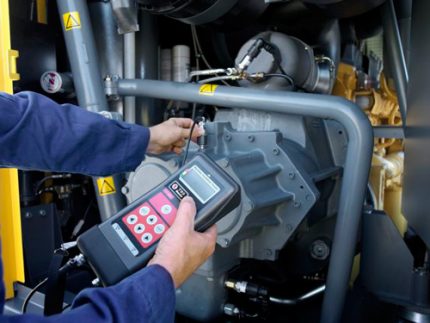
Another way to study the state of a gas pipeline is by drilling a well. Instruments are introduced into such an opening that analyze the state of the air and make it possible to identify a possible gas leak.
During such procedures, it should be remembered that the use of an open flame closer than three meters from the gas-filled communications is unacceptable.
Preparatory work and activities
Pressure testing of the gas network section is considered the most technologically advanced method for identifying design flaws. Before starting this procedure, it is necessary to perform preparatory measures. This is required in accordance with safety requirements.
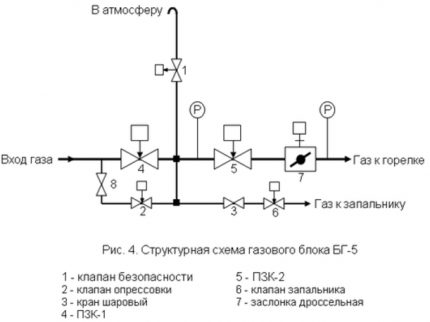
First, you should study in detail the technical documentation related to the examined object.
Based on this information, the location of such elements as:
- stub;
- a set of instrumentation;
- a set of special sensors;
- compressor.
Discussion of the procedures for the upcoming procedures, as well as training on compliance with the necessary safety rules, is held with employees performing crimping work. All control measures are carried out before the start of the new gas pipeline system by local gas facilities.
The basis for crimping before starting a new gas pipeline is the corresponding statement of the owner of a private house or other gasified facility. All other work on connection to the gas main also performed by gas service workers.
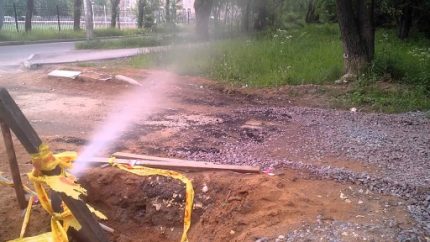
Pressure testing should be carried out in the presence of employees of the gas industry, as well as representatives of enterprises that performed installation works on the arrangement of the external and internal gas network.
In this case, specialists should have an executive design drawing. All activities are carried out in accordance with the gas pipeline operating instructions. Before pressure testing, it is necessary to purge the gas pipeline with air in order to clean it of possible contaminants.
Permission to start a new gas network can be obtained only after successful crimping. Only one person should be in charge of the entire procedure, with responsibility for the safe conduct of work. This specialist must be qualified.
For installation and removal of gas plugs, the responsibility is usually the master of the gas section, and these operations are performed by employees with the appropriate approval and qualifications of at least the fourth category.
The specialist responsible for the crimping work first reconciles the submitted executive drawings and the actual location of the network elements, all devices and gas pipes. The data must match.
Then a control inspection of the gas equipment is carried out, it is checked how correctly they work measuring devices.
After this, make sure that the protective devices are working properly, the alarm is connected correctly, the system is locked in accordance with the settings. It also checks the condition and functioning of the slam-shut boiler, burners, etc.
All operations on the control pressure testing of the gas pipeline must be formalized by issuing an admission-order, which is issued additionally. Such a document may be issued only by qualified specialists.
Gas tightness control
Only after obtaining a satisfactory result according to the procedures described above, it is possible to proceed to crimping. For this, the system is connected to a special compressor and the pipes are filled with air under pressure. Then the design is examined to identify deficiencies.

If deficiencies are identified, they are eliminated, if the system is completely tight, it is connected to a common gas pipeline. In the process of preparation, you will have to remove and install special plugs, rotary elements can be replaced with threaded connections.
In general, the procedure for crimping operations should consist of the following operations:
- To disconnect from the line the section that will be subjected to the procedure, it is necessary to shut off the high pressure valve and the low pressure network tap.
- After that, plugs are inserted.
- When the flange ruptures, shunt jumpers are used.
- To bleed off the gas inside the system, you must use a special sleeve made of rubberized fabric or perform this operation through a candle, which is usually installed on a condensate collector.
- Gas is burned, and if there is no way to do it safely, it is transported for safe storage.
- Now you need to install adapters for connecting pressure gauges and compressor.
- For pressure testing of extended systems, it is recommended to use hand pumps in addition.
Typically, control crimping is performed under a working pressure of 0.2 MPa. The recommended pressure limit is 10 daPa / h. In some industries, it is recommended to use a pressure of 0.1 MPa for crimping the internal gas pipeline, and the permissible level of drop in the indicator is 60 daPa / h or less.
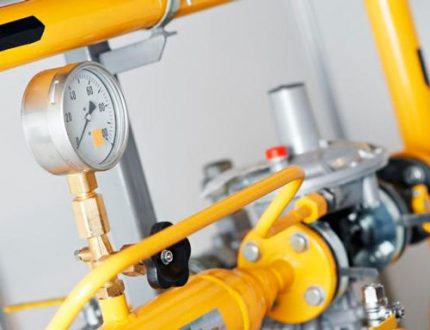
At non-production facilities, including the installation of gas pipelines in residential premises, control crimping is performed under a pressure of 500 daPa / h. The permissible pressure drop in these cases is 20 daPa in five minutes. Tanks intended for storing liquefied gas are crimped at 0.3 MPa / h.
If system pressure If it remains stable during the control time, then the result of the crimping is considered positive. If this situation is achieved, then specialists remove the hoses connecting the system to the air duct.
In this case, it is necessary to check the condition of the locking communications installed in the area between the duct and the gas pipeline. After that, plugs are installed on the fittings.
If during pressure testing it was not possible to achieve stable pressure indicators in the system, the result of the procedure is considered negative.In this case, a technical inspection of the system is performed to identify deficiencies and eliminate them. After this, the procedure is repeated to verify the quality of the work performed.
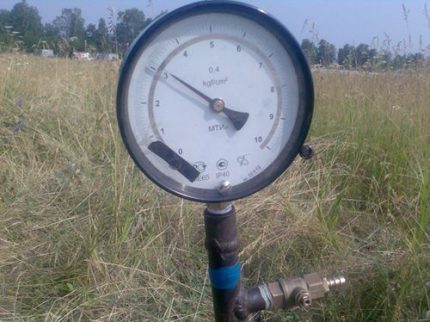
Only after a stable pressure is established in the system, pressure testing can be considered complete. If the system status check is unsatisfactory, permission to connect to the trunk will not be issued.
The reason for the refusal to commission the gas pipeline may also be violations committed during crimping.
After the crimping is completed, the pressure inside the structure is reduced to atmospheric level. Then the necessary fittings and equipment are installed, after which it is necessary to hold the system under operating pressure for another 10 minutes. To check the tightness in the places of detachable joints at this stage, use a soap emulsion.
To eliminate the identified defects, in accordance with the rules, you must first reduce the pressure in the system to atmospheric. If after unsuccessful crimping, welding work was performed, their quality should be checked by physical methods.

The procedure is recorded in the journal with operational documentation. At the end of the inspection and crimping, the results of the work are reflected in the acceptance certificate. This document should be kept with other technical documentation related to the gas pipeline. In addition, the results of crimping are recorded in the construction passport.
Example of crimping a private gas pipeline
The working documentation indicates the diameter and design features of the gas pipeline, in accordance with which the fittings necessary for inserting the control equipment are selected. Underground part of the pipe is cut so that there is some reserve.
After that, the compressor is connected to the pipe and the gas pipeline is first purged. A powerful stream of air blows particles of debris, residual water and other extraneous contents out of the system.
After that, plugs must be installed at the ends of the gas system. At one end of the pipe, where there is a ground entry, a special adapter should be installed, which allows you to attach metal equipment to the plastic structure.

A pressure gauge and a crane are installed here. After all the necessary devices are installed, air is supplied to the system so that the pressure inside reaches the desired limit. Now you need to maintain the control time to make sure that the pressure remains stable. The pressure gauge is recorded.
This is the simplest version of the procedure for checking a private gas pipeline for leaks. To perform such operations on high- and medium-pressure communications, it is necessary to use special high-precision equipment and invite specialists with the appropriate qualifications.
A few significant points
The air pressure in the gas system must be kept constant until the system is connected to the main gas pipeline. Air is usually used for crimping, but the procedure can also be carried out using an inert gas.
If a gas pipeline is connected at the enterprise, the procedure must be drawn up with relevant documents, such as an acceptance certificate, an order to appoint a person responsible for the procedure, instructions for operating the network and equipment, safety instructions, etc.
The gas pipeline, which is subjected to pressure testing, in some cases it is considered advisable to divide into several sections, which are checked separately. For this, special plugs are installed. For the same purpose, linear valves can be used in combination with shut-off devices.

In this case, it is necessary to correlate the type of selected fittings and the pressure drop, which is permissible for it. If this indicator is lower than necessary for testing, use plugs.
The network in residential buildings, as well as in administrative buildings, boiler houses, change houses and other similar objects, is checked over the entire length: from the shut-off device at the network entrance to the place of connection to equipment for which gas is used.
To perform gas tightness testing, the accuracy of 0.15 gauges is considered optimal, although devices with an accuracy of 0.4-0.6 are allowed. If the test needs to be carried out at a pressure of less than 0.01 MPa, it is recommended to use V-type liquid devices.
The part of the gas pipeline located underground should be pressure tested after the structures are laid in the trench and poured. If full backfill is considered unreasonable for some reason, then cover the pipes with a layer of soil of at least 20 cm. Welded joints of steel lines should be carefully insulated.
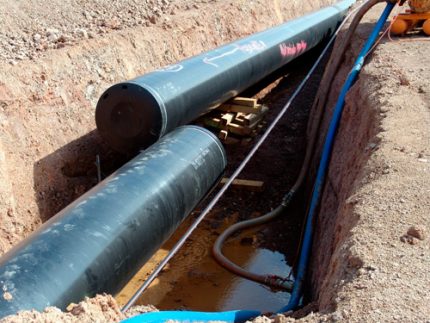
Before starting crimping, you need to wait until the air inside the structure under test pressure acquires the same temperature as the surrounding soil.
If it is necessary to check the tightness of the network laid in cases through barriers of various origins, then this must be done three times: immediately after welding the communications, after laying it in the case and completely backfilling with soil, as well as after this section is connected to the common gas pipeline system.
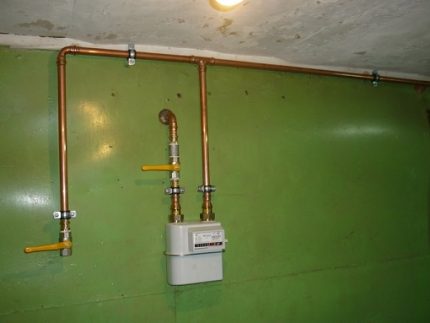
Sometimes the last step can be abandoned if there is no objection from the operating company. If the transition was performed using directional drilling, or if there are no welds under the transition, it is possible to pressure test this section after connecting to the main gas pipeline.
In the same way, crimping is performed if for welding polyethylene pipes At the transition site, high-precision automatic equipment or a system of embedded heaters was used.
Additional requirements, features, methods and procedures for tapping into a gas pipeline are described in the articles:
- How to crash into a gas pipeline: technical requirements and performance features
- Gasification of a country house: stages of connecting the cottage to the main gas pipeline
Conclusions and useful video on the topic
Detailed information on the procedure of this type is presented here:
Pressure testing is a necessary measure before starting the gas pipeline system, as well as after its repair. It must be carried out in accordance with the instructions and requirements in order to ensure an adequate level of safety and reliability of the gas pipeline.
Is there anything to supplement, or have questions about the pressure testing of the gas pipeline? Please leave comments on the publication and participate in discussions. The contact form is located in the lower block.

 Laying a gas pipeline in a case through a wall: the specifics of a device for introducing a pipe for gas into a house
Laying a gas pipeline in a case through a wall: the specifics of a device for introducing a pipe for gas into a house 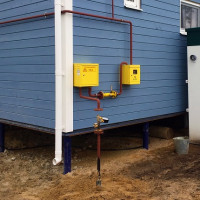 Gas pipeline exit from the ground: requirements and features of the arrangement of the exit node
Gas pipeline exit from the ground: requirements and features of the arrangement of the exit node 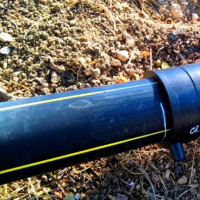 Polyethylene pipes for a gas pipeline: types and specifics of laying pipelines made of polyethylene
Polyethylene pipes for a gas pipeline: types and specifics of laying pipelines made of polyethylene 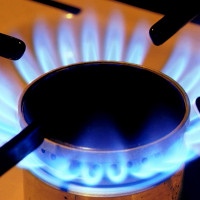 How is gas connected to a private house: input device + system installation
How is gas connected to a private house: input device + system installation 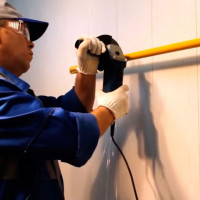 Gas pipes are changed in the house: the nuances of replacing gas pipes in an apartment building
Gas pipes are changed in the house: the nuances of replacing gas pipes in an apartment building 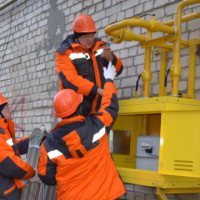 Gasification of a country house: stages of connecting the cottage to the main gas pipeline
Gasification of a country house: stages of connecting the cottage to the main gas pipeline  How much does it cost to connect gas to a private house: the price of organizing gas supply
How much does it cost to connect gas to a private house: the price of organizing gas supply  The best washing machines with dryer: model rating and customer tips
The best washing machines with dryer: model rating and customer tips  What is the color temperature of light and the nuances of choosing the temperature of the lamps to suit your needs
What is the color temperature of light and the nuances of choosing the temperature of the lamps to suit your needs  Replacement of a geyser in an apartment: replacement paperwork + basic norms and requirements
Replacement of a geyser in an apartment: replacement paperwork + basic norms and requirements
Tests of gas pipelines after repair and control pressure testing are different measures and are performed by different pressures. At you, all concepts are confused!